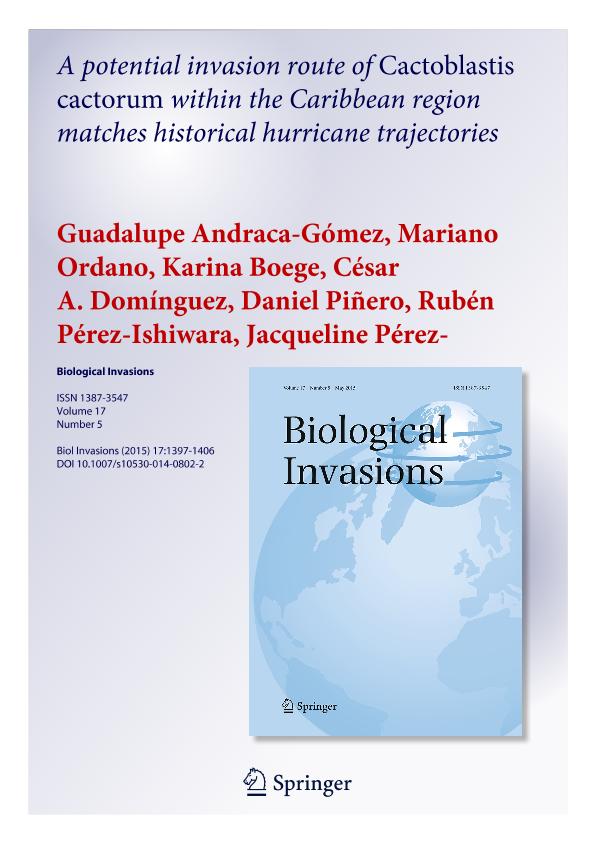Artículo
A potential invasion route of Cactoblastis cactorum within the Caribbean region matches historical hurricane trajectories
Andraca Gómez, Guadalupe; Ordano, Mariano Andrés ; Boege, Karina; Domínguez, César A.; Piñero, Daniel; Pérez Ishiwara, Rubén; Pérez Camacho, Jacqueline; Cañizares, Maikel; Fornoni, Juan
; Boege, Karina; Domínguez, César A.; Piñero, Daniel; Pérez Ishiwara, Rubén; Pérez Camacho, Jacqueline; Cañizares, Maikel; Fornoni, Juan
 ; Boege, Karina; Domínguez, César A.; Piñero, Daniel; Pérez Ishiwara, Rubén; Pérez Camacho, Jacqueline; Cañizares, Maikel; Fornoni, Juan
; Boege, Karina; Domínguez, César A.; Piñero, Daniel; Pérez Ishiwara, Rubén; Pérez Camacho, Jacqueline; Cañizares, Maikel; Fornoni, Juan
Fecha de publicación:
05/2015
Editorial:
Springer
Revista:
Biological Invasions
ISSN:
1387-3547
e-ISSN:
1573-1464
Idioma:
Inglés
Tipo de recurso:
Artículo publicado
Clasificación temática:
Resumen
The cactus moth, Cactoblastis cactorum mainly distributed throughout central and northeastern Argentina was intentionally introduced in the Caribbean region in 1957 as a biological control agent of cacti species of the genus Opuntia. This moth invaded during the last 20–30 years the North American continent, threatening the major center of biodiversity of native Opuntia species. Although human induced and natural dispersal have been invocated to explain its expansion in the non-native distribution range, there is still no evidence to support natural dispersal. In particular, hurricanes are one of the major environmental factors affecting species dispersal in the region. In this study we used mitochondrial DNA to examine whether the spatial distribution of haplotype variation of C. cactorum is at least partially explained by hurricane trajectories within the Caribbean region. DNA sequences for the mitochondrial gene cytochrome oxidase I were obtained for a sample of 110 individuals from the Antillean islands. This information was combined with existing sequences in the GenBank for the same gene for the Caribbean and Florida (N = 132 sequences). Genetic diversity descriptors, a haplotypic network, a spatial analyses of molecular variance and a landscape genetic analysis of migration conditioned by hurricane tracks were conducted to test our hypothesis. Our results revealed a significant spatial grouping of haplotypes consistent with the more frequent hurricane trajectories in the Caribbean region. Significant isolation by distance conditioned by hurricane tracks was detected. Populations of Florida were genetically closer to those of Cuba than to the rest of the population sampled. Within the region, Cuba appears as a reservoir of genetic diversity increasing the risk of invasion to Mexico and the US. Despite commercial transportation of Opuntia promoted dispersal to Florida, our results support the hypothesis that natural disturbances such as hurricanes played a role dispersing this invasive insect. Future conservation programs of North American Opuntia species requires taking into account hurricane mediated dispersal events and permanent whole regional monitoring and international control policies to prevent future range expansions of C. cactorum.
Archivos asociados
Licencia
Identificadores
Colecciones
Articulos(CCT - NOA SUR)
Articulos de CTRO.CIENTIFICO TECNOL.CONICET - NOA SUR
Articulos de CTRO.CIENTIFICO TECNOL.CONICET - NOA SUR
Citación
Andraca Gómez, Guadalupe; Ordano, Mariano Andrés; Boege, Karina; Domínguez, César A.; Piñero, Daniel; et al.; A potential invasion route of Cactoblastis cactorum within the Caribbean region matches historical hurricane trajectories; Springer; Biological Invasions; 17; 5; 5-2015; 1397-1406
Compartir
Altmétricas



